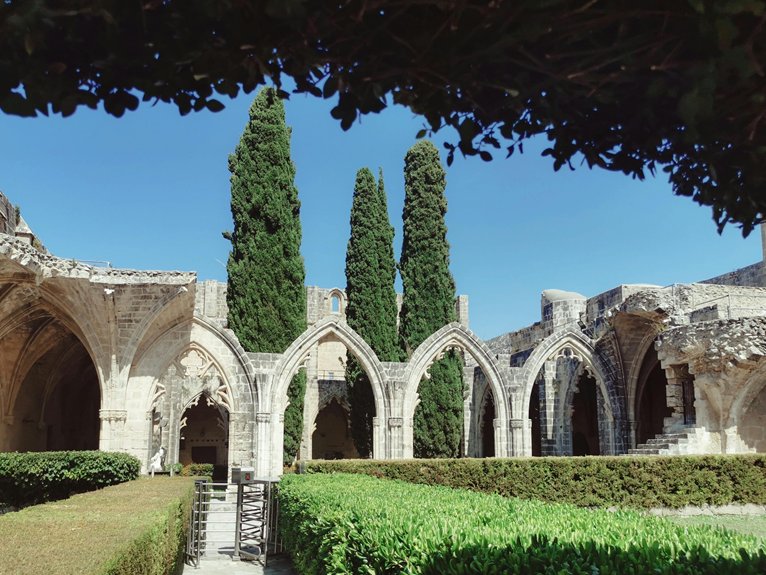You’ll discover Cyprus’s monastic treasures near Limassol by exploring UNESCO-recognized sites like Panayia Trikoukkia and Timios Stavros Church. Navigate the Troodos Mountains to encounter rock-carved sanctuaries and Byzantine architectural marvels. Engage with resident nuns, witness centuries-old frescoes, and immerse yourself in spiritual landscapes that preserve medieval religious traditions. Each monastery offers a unique window into Cyprus’s rich ecclesiastical heritage, promising deeper cultural revelations for the curious traveler.
Principaux enseignements
- Plan your monastery visits strategically, focusing on UNESCO-recognized sites like Timios Stavros Church with its 900-year-old wall paintings near Limassol.
- Respect monastic protocols by dressing modestly, maintaining silence, and understanding photography restrictions when exploring sacred Byzantine religious spaces.
- Consider timing your visit during Sunday mass or scheduled cultural events to experience authentic monastic life and spiritual traditions in Cyprus.
- Engage with local monastic communities through on-site shops selling handcrafted products, providing direct support to preservation efforts and cultural heritage.
- Select monasteries in the Troodos Mountain region for diverse architectural styles, ranging from rock-carved sanctuaries to meticulously restored 16th-century religious complexes.
Historical Significance of Byzantine Monasteries in Cyprus
As you explore the rich tapestry of Cypriot religious heritage, the historical significance of Byzantine monasteries emerges as a witness to the island’s profound spiritual and cultural legacy. These ancient monasteries near Limassol, Cyprus, represent more than architectural marvels; they’re living repositories of centuries-old religious traditions and artistic expressions.
Founded primarily in the 4th century, these Byzantine monasteries showcase a complex architectural narrative that reflects multiple cultural influences, including Romanesque, Frankish, and Venetian styles. You’ll discover that monasteries like Kykkos, Machairas, and Stavrovouni were not merely religious institutions but critical centers of social and intellectual life.
Their preservation demonstrates Cyprus’s commitment to maintaining its historical patrimony. UNESCO’s recognition of select monasteries as World Heritage Sites underscores their exceptional cultural significance. These sacred spaces continue to offer profound insights into the island’s intricate religious and cultural evolution, serving as powerful links between Cyprus’s past and present.
Top 5 Monasteries to Explore Near Limassol
Five remarkable monasteries near Limassol beckon travelers and spiritual seekers to explore Cyprus’s rich ecclesiastical landscape. Each monastery offers a unique glimpse into the region’s profound religious heritage and architectural preservation.
The Monastery of Panayia Trikoukkia provides visitors with a tranquil setting and an opportunity to purchase handcrafted products made by resident nuns. Nearby, the Timios Stavros Church showcases impressive 900-year-old wall paintings and icons under UNESCO protection, representing significant Byzantine artistic traditions.
The Holy Monastery of Panayia Amasgous stands as a secluded mountain sanctuary, renowned for its serene beauty and spiritual atmosphere. On the outskirts of Limassol, the Holy Monastery of Panayia Sfalangiotissa offers a restored 16th-century architectural marvel. Complementing these sites, the Chapel of the Saints Mavra and Timotheos provides a soothing respite, presenting traditional religious iconography and architectural splendor.
These monasteries collectively represent Cyprus’s deep-rooted ecclesiastical history and cultural significance.
Architectural Marvels of Troodos Mountain Monasteries
The monasteries nestled within Cyprus’s Troodos Mountains represent architectural treasures that transcend mere religious structures, embodying centuries of cultural complexity and architectural innovation. You’ll discover a remarkable fusion of Romanesque, Frankish, and Venetian design elements that narrate the region’s intricate historical landscape.
At the Monastery of Panagia tou Sinti, you’ll encounter an architectural marvel with a haunting legend of artistic rivalry, while the Monastery of Saint Neophytos the Hermit reveals extraordinary rock-carved sanctuaries that demonstrate medieval monastic engineering. The Monastery of St John the Baptist exemplifies architectural resilience through its extensive restoration efforts.
UNESCO’s recognition of these monasteries underscores their profound cultural significance. Their architectural details-from intricate stone masonry to ingeniously designed spaces-offer you a profound window into Cyprus’s rich ecclesiastical heritage, where each structure represents a complex narrative of artistic expression, religious devotion, and historical transformation.
Spiritual and Cultural Experience in Monastic Communities
While Cyprus’s monastic communities represent far more than architectural monuments, they embody living repositories of spiritual heritage and cultural continuity. You’ll discover that these sacred spaces offer profound insights into the island’s religious traditions, inviting deep personal reflection and cultural immersion.
When you visit monasteries like Kykkos or Stavrovouni, you’ll encounter opportunities to engage directly with monastic life. Attending Sunday mass, interacting with resident nuns, and exploring on-site shops provide intimate glimpses into centuries-old practices. The serene environments, often nestled in picturesque landscapes, create transformative spaces for contemplation and spiritual exploration.
Each monastery serves as a dynamic cultural center, preserving Byzantine frescoes, sacred relics, and intricate religious artifacts. By participating in these experiences, you’ll gain nuanced understanding of Cyprus’s rich spiritual landscape, connecting with traditions that have sustained local communities for generations.
Preservation and Restoration of Ancient Religious Sites
Since ancient monasteries represent critical architectural and spiritual heritage in Cyprus, preservation and restoration efforts have become paramount in safeguarding these irreplaceable cultural landmarks. You’ll find that Cypriot authorities have strategically invested in extensive conservation projects to maintain these historic sites’ integrity and historical significance.
Cypriot monasteries: sacred architectural treasures meticulously preserved to protect their profound cultural and spiritual heritage.
Key preservation strategies include:
- Carefully blending restoration work with the surrounding natural landscape
- Meticulously reviving medieval frescoes and architectural details
- Securing substantial funding for long-term conservation efforts
- Ensuring monasteries remain active cultural and spiritual centers
The UNESCO World Heritage-listed Panagia tou Sinti Monastery near Paphos exemplifies these dedicated restoration approaches. Sites like the Monastery of Panayia Trikoukkia demonstrate how experts seamlessly integrate new architectural elements while respecting original structures. Ongoing maintenance projects at monastic sites across Cyprus protect these ancient religious landmarks from deterioration, allowing future generations to experience and appreciate the rich spiritual and architectural heritage embedded in these remarkable historical monuments.
Practical Visitor Guide for Monastery Exploration
Wondering how to navigate the spiritual and historical landscapes of Cyprus’s ancient monasteries near Limassol? Start by planning your visit to sites like the Monastery of Panayia Trikoukkia, where you’ll discover a serene environment nestled among pine and cypress trees. Upon arrival, explore both the ancient and newly restored churches, taking time to appreciate their architectural and historical significance.
Consider attending Sunday mass at the monastery to immerse yourself in the authentic monastic experience. The nuns’ warm hospitality often includes complimentary coffee and snacks after the service. Don’t miss the small on-site shop, where you can purchase locally produced goods crafted by the resident nuns.
For a profound spiritual journey, visit the UNESCO-protected Timios Stavros Church, renowned for its 900-year-old wall paintings and icons. The Holy Monastery of Panayia Amasgous offers an equally transformative experience, set in a breathtaking mountain landscape that promises tranquility and spiritual reflection.
Hidden Gems: Lesser-Known Monasteries Around Limassol
Beyond the well-trodden paths of Limassol’s famous monasteries, a rich tapestry of lesser-known spiritual sanctuaries awaits discerning travelers and cultural enthusiasts. These hidden gems offer profound insights into Cyprus’s ecclesiastical heritage and architectural preservation.
Beyond the familiar, discover Cyprus’s hidden monasteries-spiritual havens revealing profound ecclesiastical heritage and architectural elegance.
- The Monastery of Panagia Amasgous provides a serene mountain retreat, inviting contemplative exploration of its secluded landscape.
- The Holy Monastery of Panayia Sfalangiotissa, meticulously restored in 1977, represents remarkable architectural resilience and historical continuity.
- The Chapel of the Saints Mavra and Timotheos presents an intimate spiritual experience, adorned with traditional Byzantine iconography and architectural elegance.
- The Monastery of Panayia Trikoukkia stands as a multifaceted cultural landmark, offering visitors not only spiritual reflection but also opportunities to engage with local monastic traditions through its on-site shop.
These monasteries transcend mere architectural structures, embodying living testimonies of Cyprus’s rich religious and cultural landscape, inviting deeper understanding through immersive, contemplative experiences.
Questions fréquemment posées
Is KYKKOS Monastery Worth Visiting?
You’ll find Kykkos Monastery absolutely spellbinding, offering a profound glimpse into Cypriot religious heritage. Located in the Troodos Mountains, this UNESCO-recognized Byzantine treasure showcases remarkable iconography and architectural significance. You’ll be impressed by its stunning gold-leafed icons, intricate frescoes, and historical importance as one of Cyprus’s most significant Orthodox monasteries. Its elevation and panoramic mountain views further enhance your cultural exploration, making it a must-visit destination for history and art enthusiasts.
What Is the Oldest Monastery in Cyprus?
The Agios Nikolaos ton Gaton Monastery is considered Cyprus’s oldest monastery, boasting an incredibly rich historical significance. You’ll find it east of Akrotiri near Limassol’s Salt Lake, distinguished by its ancient architectural features and deep cultural roots. UNESCO has recognized this remarkable site, highlighting its importance in preserving Cyprus’s monastic heritage. Its dedication to Saint Nicholas further enhances its spiritual prominence.
What Is the Dress Code for Kykkos Monastery Cyprus?
At Kykkos Monastery, you’ll need to respect a strict dress code that reflects its religious significance. Women must cover their heads and shoulders, while men are required to wear long pants. If you’re not appropriately dressed, you’ll be provided with shawls or scarves at the entrance. Avoid shorts, sleeveless tops, and revealing clothing to guarantee entry and demonstrate reverence for this sacred Greek Orthodox site.
What Is the Richest Monastery in Cyprus?
You’ll be amazed that the Kykkos Monastery is considered Cyprus’s wealthiest ecclesiastical institution, boasting an extraordinary treasury of Byzantine artifacts. Located in the Troodos Mountains, this 11th-century monastery houses one of three icons attributed to Saint Luke the Evangelist. Its vast collection of religious treasures, including rare icons, vestments, and relics, solidifies its status as the most prestigious and financially significant monastery on the island.
Conclusion
You’ll discover Cyprus’s spiritual landscape isn’t just stone and silence-it’s a living tapestry of Byzantine devotion. Like pilgrims centuries before you, these monasteries whisper ancient narratives through centuries-old frescoes and hallowed stone walls. Your journey through Limassol’s monastic treasures transcends mere tourism; it’s an immersive voyage into a profound cultural and spiritual heritage that continues to resonate with timeless significance.

Voici Natalie, qui vit à Chypre depuis dix ans. Elle adore explorer la belle nature de l'île, comme les forêts tranquilles et les plages vierges. Natalie a beaucoup d'expériences intéressantes à partager. Rejoignez-la lorsqu'elle vous parlera de ses aventures à Chypre.

